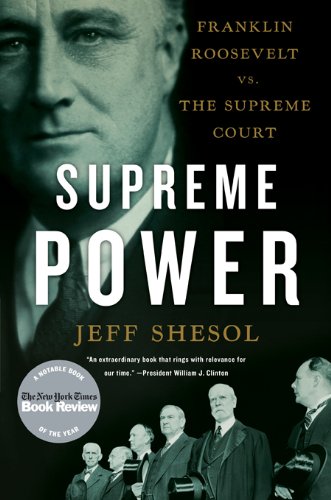
Jeff Shesol, Supreme Power: Franklin Roosevelt vs. The Supreme Court. New York, N.Y. : W.W. Norton & Company, 2010.
This 2010 book attracts interest for its coverage of a subject that arose during last year’s presidential campaign. On the issue of court packing, author Jeff Shesol describes political and legal events of the 1930s related to the New Deal and the Supreme Court. The author explains difficult topics in detail, specifically the viability of the New Deal, the economic order during the depression, and Roosevelt’s attempts to pack the court to sway its rulings in favor of his programs. As the story unfolds, the parallels to current political and legal events are apparent, and not solely on the issue of court packing.
The author explains the 1930s legal background and historical framework. While the Constitution is silent on the size of the Supreme Court, the number can be changed by Congress. In fact, the number of justices has changed over the past centuries: in 1789 there were six justices; in 1801 there were five; in 1837 there were nine; and in 1863 it rose to ten to secure the Court’s support for Lincoln’s war policies. The shifting number of justices reflected the political power of the congressional and the executive branches. In 1866, there were nine justices on the court, and that number has remained ever since.
The depression of the 1930s fostered Roosevelt’s New Deal, and with it, new political initiatives that had major ramifications for the nation, especially as they impacted laissez-faire, federal control (and the emerging welfare state), and the interplay of congressional decisions and court action. The ensuing battle with the Supreme Court, which Roosevelt feared would strike down various components of the New Deal, also engendered questions about the rigidity or flexibility of the constitutional landscape. As Shesol reveals, in 1937 Roosevelt devised a strategy to save his progressive proposals—by increasing the number of justices on the court from nine to fifteen and thereby securing a more liberal majority of justices who would favor his policies. This proposal became increasingly disdainful among many individuals including those Roosevelt considered his supporters. The court packing bill was ultimately eliminated by the Senate Judiciary Committee.
The many parallels to current events include the following:
| Event | 1930s | 2020 |
| National Emergency | The Great Depression | The Global Pandemic |
| Federal Legislative Initiative | The New Deal | Build Back Better |
| State Legislative Initiatives | The Mortgage Moratorium | Mortgage/Eviction Moratorium |
| Supreme Court Split Decisions | Chief Justice in flux | Chief Justice in flux |
The mortgage moratorium of the thirties had ties to Minnesota. A major court case originated when John H. Blaisdell was sued by the Home Building Association regarding a new Minnesota law that was passed as an emergency measure to place a moratorium on mortgage payments and foreclosures. The Loan Association argued that the law violated the contract and due process clauses of the Constitution. The U.S. Supreme Court, however, ruled that the Minnesota legislature was justified in enacting the moratorium law as an emergency measure under the police power of the state (see Home Building and Loan Ass’n. v. Blaisdell, 290 U.S., 1934). Shesol notes that this was the first of the New Deal cases that came before the Supreme Court (p. 65).
As far as who might pack the court in the thirties despite a more evenly divided Supreme Court, Roosevelt directly strategized to pack the court to ensure that his New Deal policies would advance. His efforts met with great opposition. In comparison, today’s Court is more conservative than its 1930s counterpart and is one of the reasons President Biden received many questions about court packing during his presidential campaign. While President Biden has skirted the issue about court packing, it’s likely to re-emerge with the Court’s conservative decision-making. For an understanding of court packing and The New Deal, Shesol gives a detailed and well-documented perspective about the individuals and the processes involved.